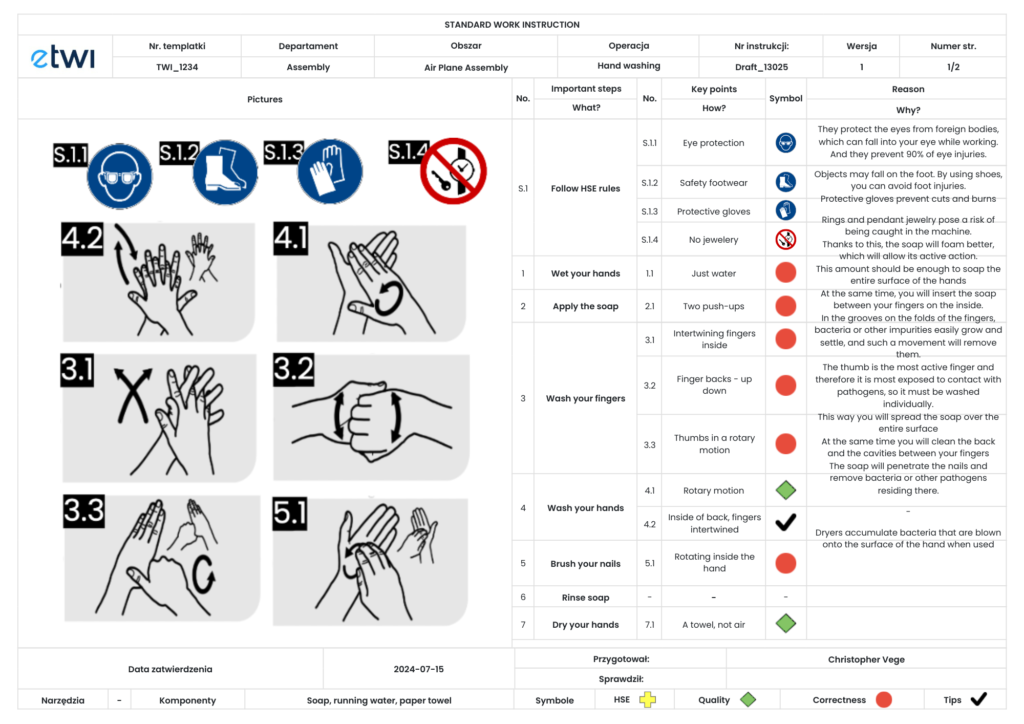This article is about calculating savings from digitalization. We would like to describe some case studies. Digitalization has become more than just a buzzword, it’s a critical strategy for organizations aiming to enhance efficiency and reduce costs. While the initial investment in digital tools may seem significant, the long-term savings often outweigh the costs. This article explores how to calculate the savings from digitalization, particularly in replacing traditional methods like Excel with specialized software for creating work instructions.
Table of Contents
ToggleThe Hidden Costs of Traditional Methods
Time-Consuming Processes
Using tools like Excel for creating work instructions is a common practice in many organizations. However, this approach is often time-consuming and inefficient. Crafting a single work instruction in Excel can take anywhere from 3 to 3.5 hours. The process involves:
- Documenting production standards
- Formatting text and layouts
- Inserting images and icons
- Managing revisions and updates
Inefficiencies and Errors
Excel isn’t designed for creating detailed work instructions. The lack of specialized features can lead to:
- Formatting issues
- Version control problems
- Increased likelihood of errors
- Difficulty in updating and maintaining documents
These inefficiencies not only consume valuable time but also divert resources from more strategic tasks.
Digitalization as a Solution
Specialized Software Advantages
Implementing specialized software for creating work instructions offers numerous benefits:
- Time Efficiency: Create instructions in 40 to 50 minutes, significantly faster than using Excel.
- User-Friendly Interface: Features like drag-and-drop editing and voice recording simplify the creation process.
- Real-Time Updates: Make instant changes without dealing with cumbersome revisions.
- Accessibility: Use mobile devices like phones or tablets directly on the production floor.
Streamlining Processes
By leveraging digital tools, organizations can streamline their processes, reduce errors, and improve overall productivity. Digitalization eliminates redundant tasks and automates many aspects of work instruction creation.

TWI Work Instruction in etwi software – Calculating Savings from Digitalization
Calculating Savings from Digitalization
Time Saved
Consider an organization that needs to create 200 work instructions:
- Using Excel:
- Time per instruction: 3 hours
- Total time: 200 instructions × 3 hours = 600 hours
- Using Specialized Software:
- Time per instruction: 0.75 hours (45 minutes)
- Total time: 200 instructions × 0.75 hours = 150 hours
- Time Saved: 600 hours – 150 hours = 450 hours
Cost Implications
Assuming an average hourly wage for an engineer is $20 per hour:
- Total Cost Using Excel: 600 hours × $20/hour = $12,000
- Total Cost Using Software: 150 hours × $20/hour = $3,000
- Cost Savings: $12,000 – $3,000 = $9,000
Return on Investment (ROI)
If the investment in the specialized software is $5,000, the net savings would be:
- Net Savings: $9,000 – $5,000 = $4,000
This calculation demonstrates a clear financial benefit from digitalization. The savings will also be visible when updating documentation.
Understanding Different Types of Savings
Digitalization can lead to various types of savings. Understanding these categories helps in accurately assessing the benefits.
Hard Savings
Definition
Hard savings are direct cost reductions that positively impact the bottom line. They are tangible and can be directly measured in financial statements.
Examples
- Reduction in labor costs due to decreased overtime
- Lower material costs from bulk purchasing
- Savings from eliminating redundant software licenses
Soft Savings
Definition
Soft savings are indirect benefits that may not immediately reflect on financial statements but improve operational efficiency.
Examples
- Improved employee satisfaction
- Enhanced customer experience
- Reduced downtime due to streamlined processes
Cost Avoidance
Definition
Cost avoidance refers to actions that prevent future costs. While not reflected as savings in financial statements, they contribute to long-term financial health.
Examples
- Avoiding costs associated with equipment breakdowns through preventive maintenance
- Reducing potential fines by complying with regulations
- Saving on future training costs by implementing user-friendly software
How Digitalization Relates to These Savings
Implementing digital tools for creating work instructions primarily leads to cost avoidance and soft savings:
- Cost Avoidance: By reducing the time spent on creating and updating instructions, organizations avoid the costs associated with inefficiencies and errors.
- Soft Savings: Enhanced productivity and employee satisfaction from using intuitive software contribute to operational improvements.
Case Study: Implementing Digital Work Instruction Software
Scenario
An organization decides to replace Excel with specialized software for creating work instructions. Here’s how the implementation impacts their operations.
Time and Cost Analysis
- Number of Instructions: 150
- Time Saved per Instruction: 2.25 hours (from 3 hours in Excel to 0.75 hours in software)
- Total Time Saved: 150 × 2.25 hours = 337.5 hours
- Hourly Wage: $25 per hour
- Total Cost Savings: 337.5 hours × $25/hour = $8,437.50
Additional Benefits from Digitalization
- Improved Accuracy: Reduction in errors due to standardized templates and validation features.
- Enhanced Collaboration: Real-time updates and cloud access facilitate better team collaboration.
- Employee Satisfaction: User-friendly interfaces reduce frustration and training time.
Measuring and Recognizing Savings in Lean Management
Importance of Measurement
In lean management, measuring savings is crucial for continuous improvement. Recognizing all types of savings ensures a comprehensive understanding of the benefits.
Incorporating Cost Avoidance
While cost avoidance doesn’t immediately impact the bottom line, it’s essential for long-term financial planning. Organizations should:
- Document Avoided Costs: Keep records of potential costs prevented through digitalization.
- Include in Performance Metrics: Factor cost avoidance into efficiency and productivity assessments.
- Communicate Value: Share these savings with stakeholders to highlight the benefits of digital initiatives.
Conclusion – Calculating Savings from Digitalization
Digitalization offers a pathway to significant savings by streamlining processes and reducing inefficiencies. Replacing traditional methods like Excel with specialized software for creating work instructions can lead to substantial time and cost savings, primarily through cost avoidance and soft savings.
Organizations should carefully calculate these savings to justify the investment in digital tools. By understanding and measuring hard savings, soft savings, and cost avoidance, businesses can make informed decisions that contribute to their long-term success.
Ready to Embrace Digitalization?
If you’re looking to create work instructions three times faster than using Excel, consider implementing specialized software solutions. Transform your operations, enhance productivity, and realize significant savings.
Contact us at contact@etwi.io or on our website to get started!





